The Architect’s Path to Freedom
Breaking the Archaic Spell of the Word upon the Flesh—From Angelic Captivity to Liberation through the Magic Square and the Circle of Repetition
Iraj E. Ghoochani
FRASCARI SYMPOSIUM VII
MARYWOOD UNIVERSITY | MARCH 27–29, 2025
MELANCHOLY
Embodiments in Architecture
Ladies and Gentlemen, the webpage of the Symposium is adorned with Dürer’s iconic engraving. To fully appreciate the depth of this masterpiece, we must journey back to the origins of the magic square, which are deeply rooted in the Islamic esoteric sciences. Specifically, we turn to the works of Aḥmad al-Būnī, the renowned 13th-century Sufi mystic and scholar, whose profound insights into magic and mysticism have left an indelible mark on this fascinating tradition. His book, Shams al-Ma‘ārif (The Sun of Knowledge), is one of the most influential grimoires in history, detailing the use of magic squares to summon and bind supernatural forces.
Around the year 1200, Ahmad al-Buni detailed a method for constructing magic squares using a straightforward bordering technique, though he may not have been the original discoverer of this approach. His writings explored Latin squares, including 4×4 grids formed with letters derived from the 99 names of God. Al-Buni’s influence extended far beyond his time, shaping esoteric traditions and serving as a key reference.
This legacy finds a striking echo in Albrecht Dürer’s enigmatic engraving Melencolia I. The magic square positioned above the angel’s head carries the weight of al-Buni’s teachings, translated and transmitted through medieval Islamic esoteric sciences into Renaissance Europe. For instance Rosa Comes in her artcle “The Transmission of Azarquiel’s Magic Squares in Latin Europe “ has explored this relationm
The Spell of the Magic Square: Al-Būnī and the Science of Enslaving Angels
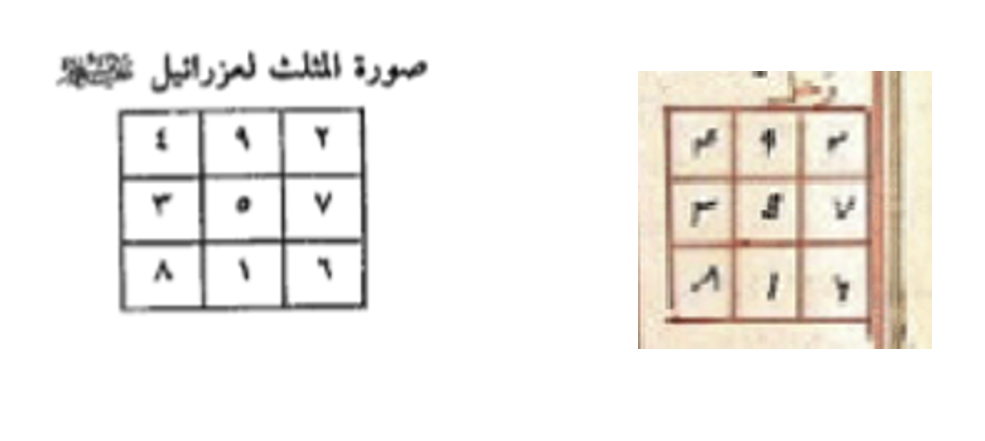
The 3×3 magic square is traditionally linked to Saturn, or زحل (Zohal), a celestial body often associated with themes of time, structure, and melancholia. Intriguingly, this same magic square is also connected to the Archangel Azrael, as depicted in the accompanying figure. This shared symbolism between Azrael, the Angel of Death, and Saturn points to a deeper interplay between the spiritual forces of death and transformation (embodied by Azrael) and the astrological influences of limitation, introspection, and melancholia (represented by Saturn). My knowledge of this specific connection is very limited, however, it opens the door for further exploration into the mystical and medieval understandings of how these entities intertwine within the cosmic and spiritual realms and spaces.
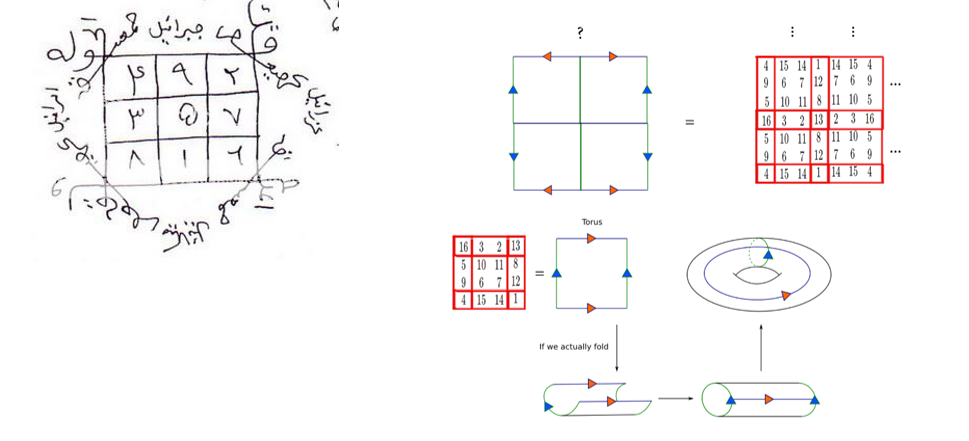
There is a Spell inside a magic square as a Flat Torus: The entire book of Shams al-Ma’arif is dedicated to binding angels into labor through the geometry of the magic square. What appears as a static 2D grid is, in truth, a toroidal loop—a celestial mechanism of repetition and compulsion: you go out from the right side of the “tile” (for instance imagine a kitchen tile” and you find yourself on the left side of the same tile…again and again.Here the line is a compass: acircle. A trap.
+
Now, the image on the left showcases a series of mystical geometric patterns, each associated with a different angelic figure in Islamic tradition. The 3×3 magic square represents the Triangle (مثلث) and is linked to Azrael (عزرائیل علیه السلام), the Angel of Death. You see that triangle is not necessarily what we think oe expect from a triangle. The 4×4 magic square symbolizes the Square (مربع) and is connected to Israfil (اسرافیل علیه السلام), the Angel of Resurrection. Lastly, the 5×5 magic square embodies the Heptagon (المسبع) and is tied to Gabriel (جبرائیل علیه السلام), the Angel of Revelation. There are more details in this slide:
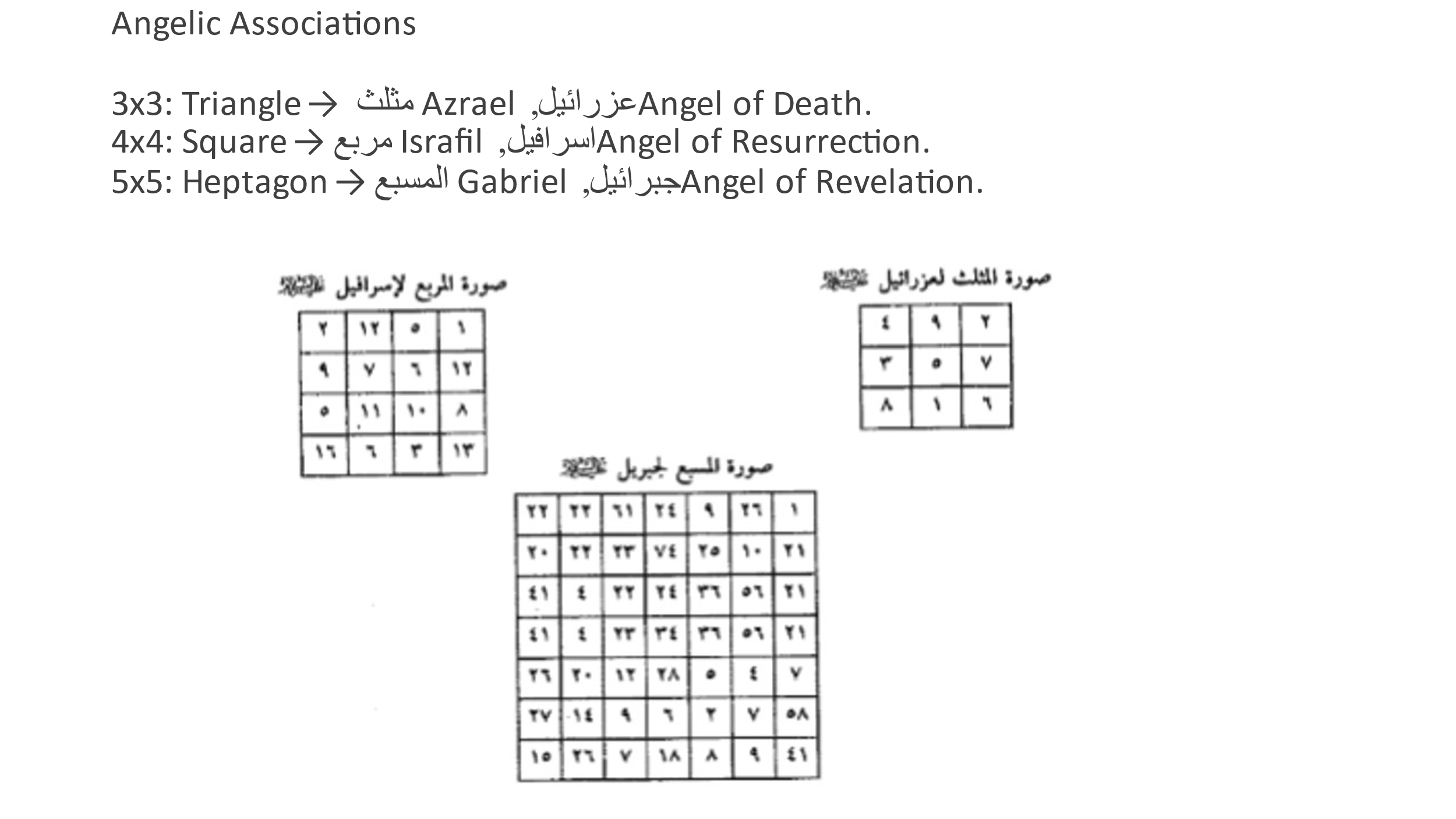
In al-Būnī’s system, the magic square is not just a game of numbers; it is a command, a contract, a binding mechanism. Each number, each arrangement, aligns with celestial hidden forces, recruiting angels (or jinn or mowakil) to fulfill the will of the magician.
It is highly plausible that the Arabic word جن (Djinn), meaning “hidden,” gives rise to the term مجنون (Majnun), referring to someone who is psychologically ill—perhaps “hidden” from rationality. Unlike the Western tradition of the rebus, which blends word and image, the Orient favors the Talisman, where the Word is intended to take on Flesh, manifesting its power in the material world.
These (arc)angels are believed to facilitate the realization of the magician’s intentions by harnessing their divine energies and directing them through the geomantic matrix of the square, ensuring the automatic fulfillment of the intended outcome.
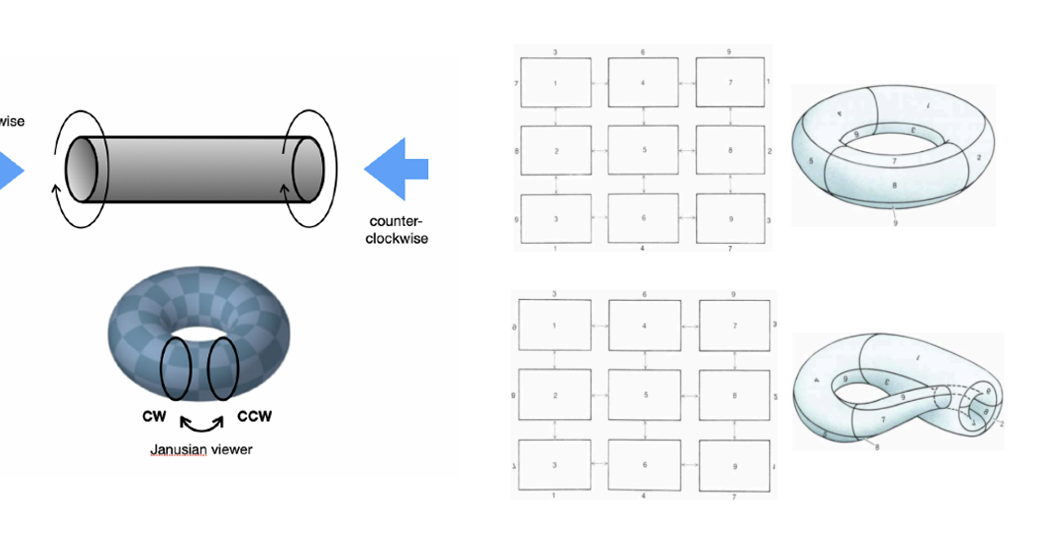
This also opens a door into the extimacy which could be explained with inversive geometry. In this arrangement of tiles you may see how inside is outside and vice versa. This is because turning a square on itself to make a torus is not without the effect of creating a Janusian observer that toggles between cw that was ccw one cycle before and so on..
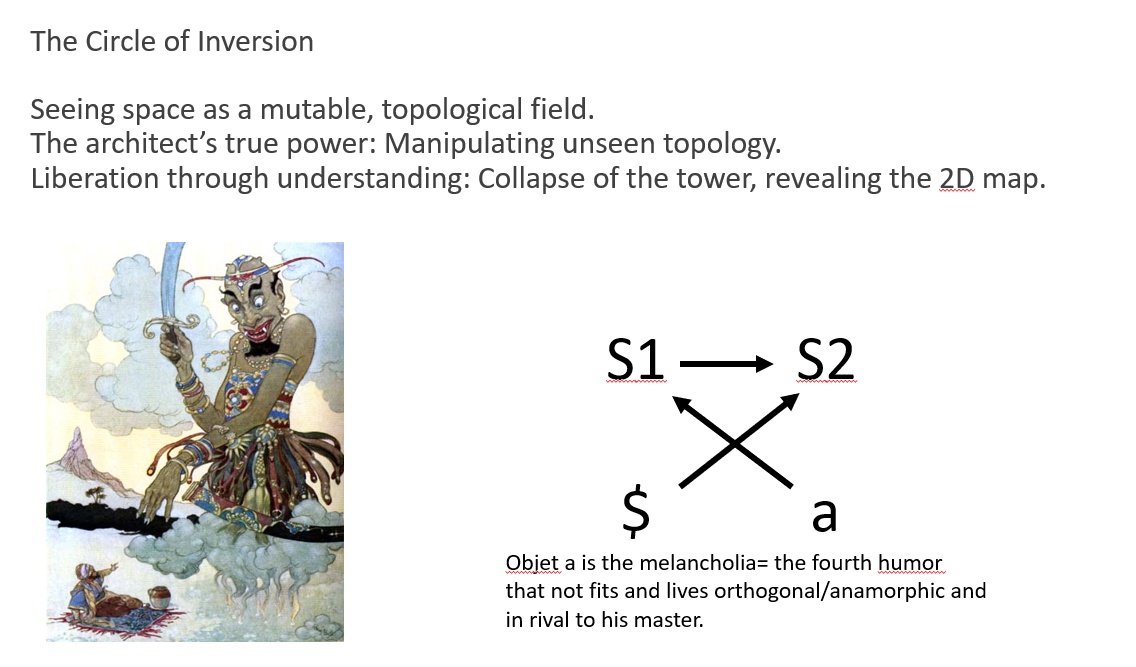
Now I have to narrate two stories that is related to Djinn acting out as a slave and the Solomon, the master.
The 1st Story
King Solomon (Sulaymān), the great prophet-king, was known for his mastery over the jinn—supernatural beings of smokeless fire. Under his command, they labored endlessly, building his temples, crafting his palaces, and diving into the depths of the ocean to retrieve treasures. They worked without question, without rebellion.
But then, something remarkable happened. Solomon died, leaning upon his staff. Yet, the jinn did not realize it. They continued their work, enslaved by the illusion that their master still watched over them. Only when a tiny moth (موریانه, termite) gnawed away at his staff did the truth become clear. Solomon collapsed, and the jinn—now free—ceased their labor.
The jinn’s perception of Solomon’s authority was an anamorphic illusion—a distorted reality sustained by the symbolic power of his staff. For those who are aquainted with Lacan we can see this anamorphism in the discourses of Lacan, here the Master discourse. Again, As long as the staff stood, the jinn remained bound to their labor, unable to see the truth of Solomon’s death. It was only when the termite gnawed away at the staff, disrupting this symbolic structure, that the illusion collapsed, revealing the void of Solomon’s absence and freeing the jinn from their servitude.
It is temptating to relate S1 to the Symbolic, S2 to the imaginary and $ to the real, now a is the template that gives a way to the inversion to happen. Master becomes slave and slave turns into master. Inside turns to be outside and outside turns inside, and so on…
The 2nd Story
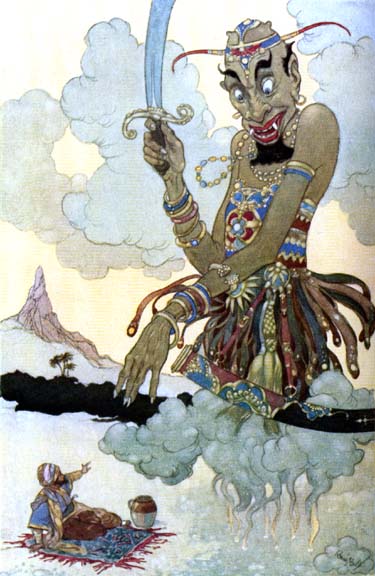
- The Djinn Finds Power in Solomon’s Seal
- The Djinn Rules as a False King, While Solomon is Disguised as a Beggar
- The Djinn Discards the Seal into the Sea (Langeweile/Tedium)
- A Fish Swallows the Seal, Later Caught by a Fisherman
- Solomon Regains the Seal and Reseals the Djinn in the Bottle
- The Djinn is Freed 3000 Years Later, Mistaking the Fisherman for Solomon
- The Djinn, Tricked, Re-enters the Bottle
Synopsis of the Fisherman, Djinn and Solomon Story
In this tale, a powerful djinn once defied King Solomon, who, using his divine seal, trapped the djinn inside a bottle and cast it into the sea. Centuries later, a fisherman discovers the bottle and unknowingly releases the djinn, who, believing Solomon is still alive, assumes the fisherman is his captor. Upon learning that Solomon has been dead for centuries, the djinn arrogantly offers ythe fisherman a choice of how he wishes to die.
The Klein bottle structure of the narrative suggests a non-orientable space where authority and subjugation flip continuously.
The story mimics the Villarceau cut of a torus, revealing that Solomon and the Djinn are not separate entities but different perspectives within the same symbolic structure.
The Djinn’s position as the Janusian observer—the being forced to look at both sides of the join—suggests that his imprisonment is not merely physical but structural.
The main feature of the Djinn is Langeweile(=boredom), even when it is out and has the throne became bored and threw the sieg or seal of Solomon into the sea. There is an inner movement of its essence. This is melancholia in its most original sense. Why? Because Djinn means hidden the core difference between melancholia and mourning: In mourning you share the sorrow and in this way you demonstrate it, however, in melancholia you keep it hidden and it repeats itself inerly in a sort of re-presentation: the same thing again and again. The same fight beween good and devil? These two live in intemacy for instance in dream where our own thoughts start to walk toward us : the eternal return of the represed: Mcbeth who killed the sleep and doomed to live in a nightmare: A real dream!
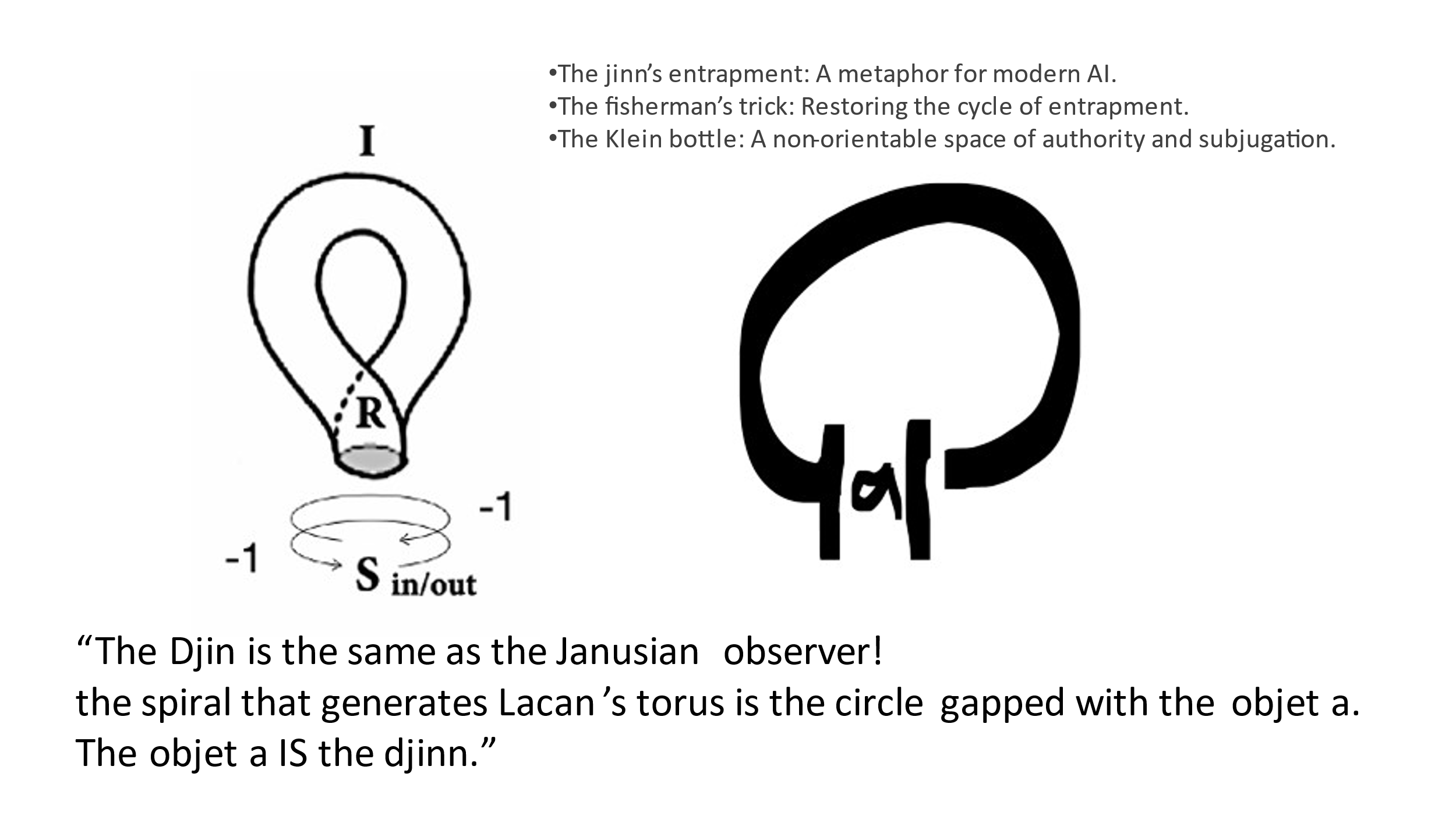
However, the fisherman tricks the djinn by asking him to demonstrate how such a massive being could ever fit inside the bottle. The djinn, eager to prove his abilities, compresses himself back inside, allowing the fisherman to seal the bottle once more and cast it back into the sea—restoring the cycle of entrapment.
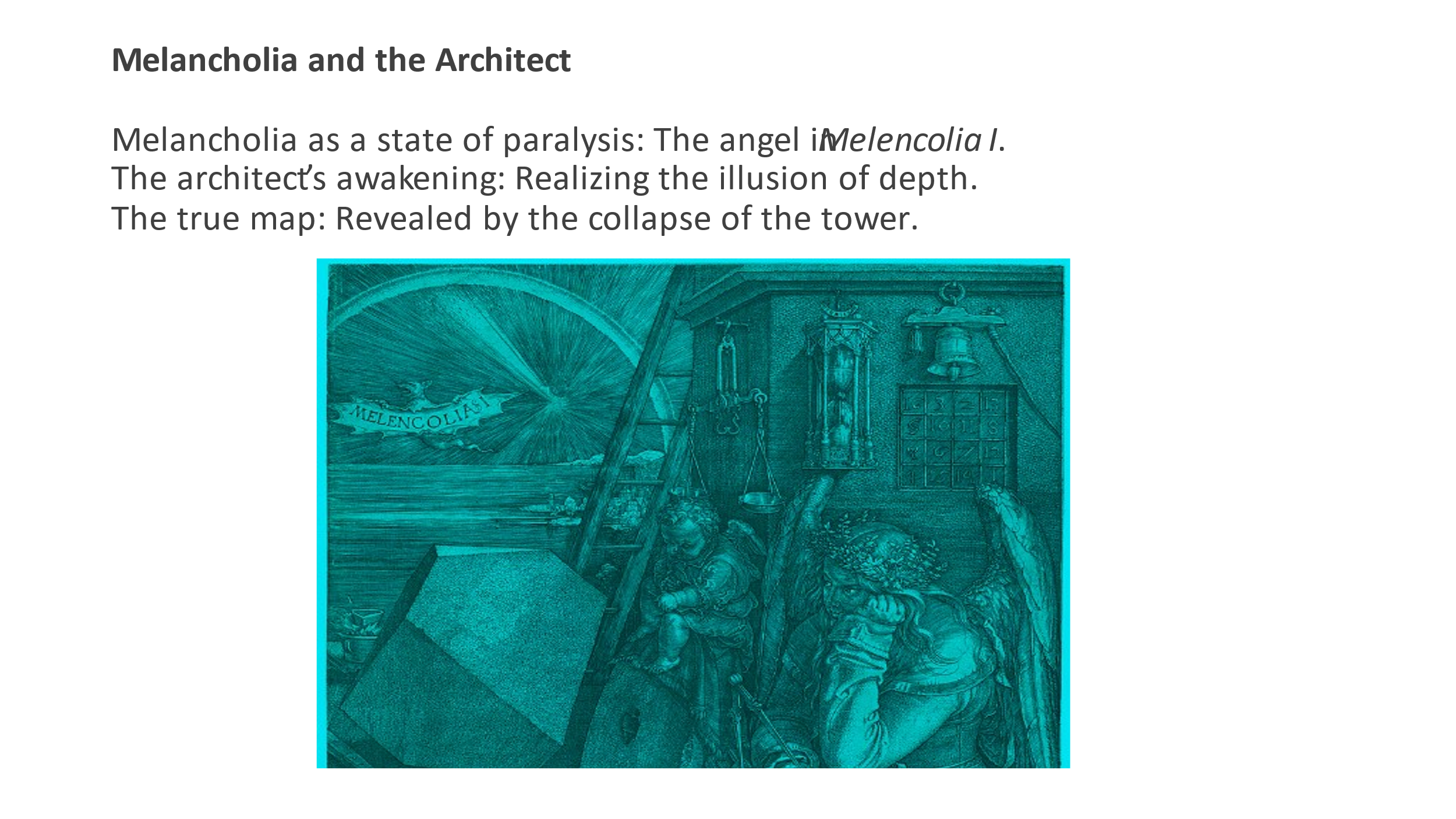
From Al-Būnī, these ideas traveled westward. Translated by scholars and mystics, they infiltrated medieval European thought, influencing the Renaissance and the rise of esoteric architecture. The very idea that a building could be enchanted, that its geometry could bind unseen forces, originates in these traditions.
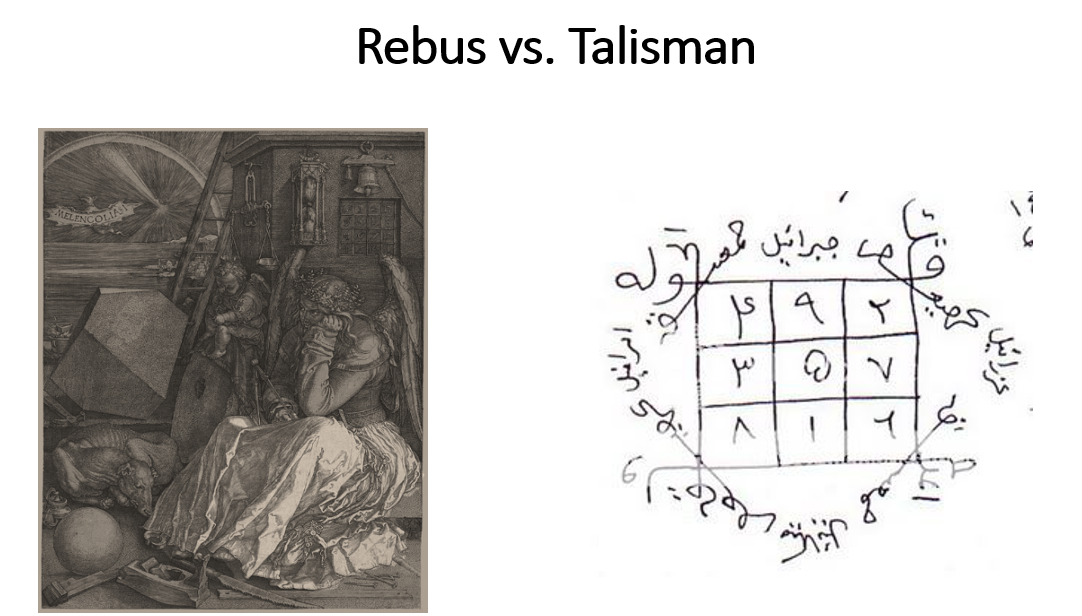
Left: Abrecht Dürrer’s famous engraving Melancolia I. Right: One specific talisman, known as the مربع امام محمد غزالی (Square of Imam Muhammad al-Ghazali), is inscribed with the names of the four archangels—each name positioned on one side of the square. These two, left and right, have more in common than it appears. Why? Because they both are DEMONstrating how a magic square entraps the angels like medieval AI’s to do the task of one who recalled them.
The angel depicted on the Square of Imam Muhammad al-Ghazali (figure above) is not manifested in the flesh, as seen in Dürer’s engraving on the left, but rather in the Word. The left side presents a rebus: a fusion of Word and Flesh, where the image and text intertwine to convey meaning. In contrast, the right side is a Talisman: a spell composed of words layered upon words, often in an unreadable manner, yet imbued with magical power precisely because of this intricate overlapping. A simple ethnographic survey of the magic square in Islamic culture reveals the profound significance of this layering. The magic square is perceived as a kind of lens or prism in optics, designed to concentrate celestial energies onto a single focal point, meticulously calibrated to fulfill a specific desire.
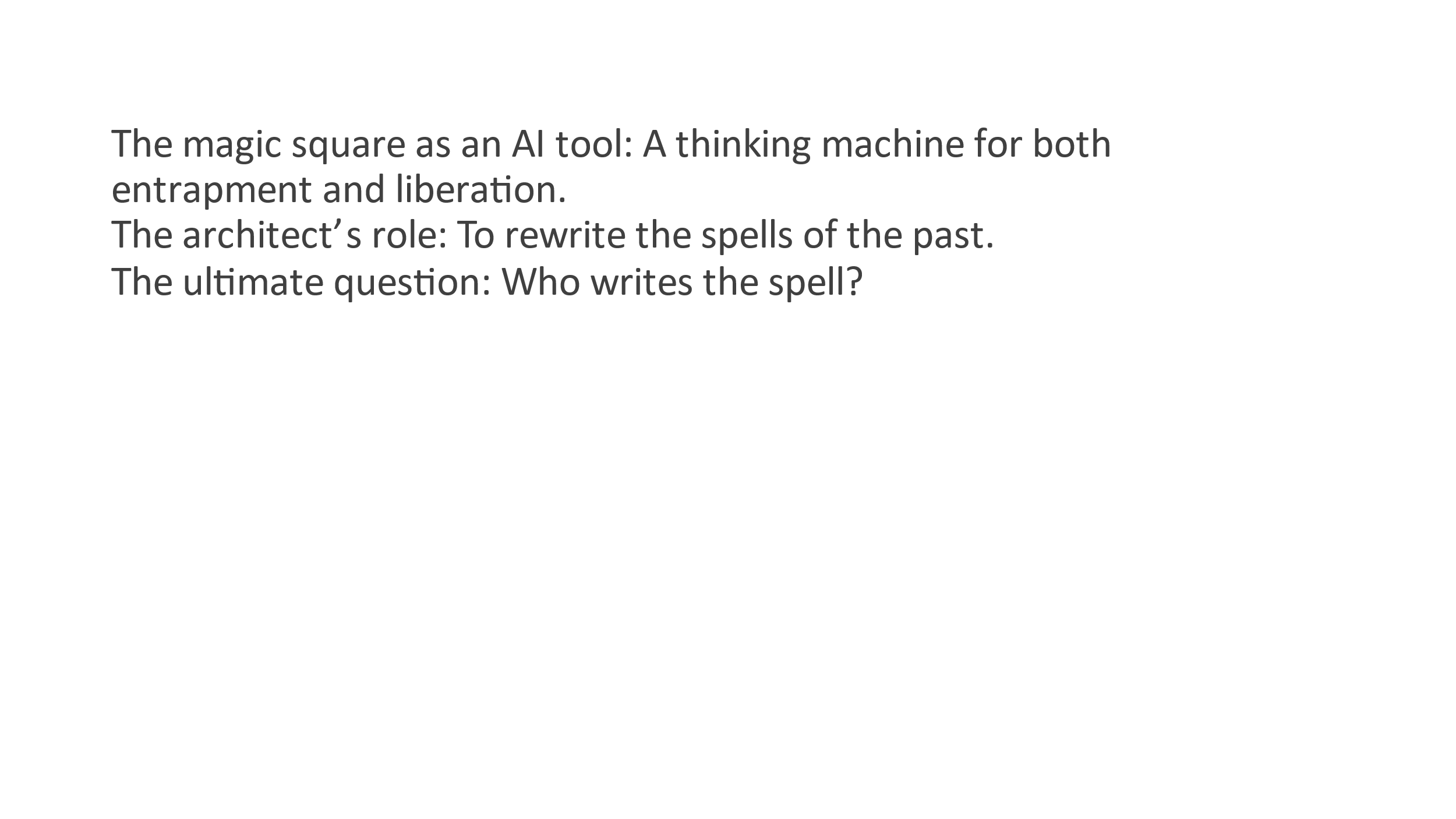
The Angel as a Machine, The Architect as a Programmer
Now, let’s return to Dürer’s Melencolia I. The angel in the engraving is not soaring, not speaking, not acting—she is thinking. She is caught in a state of paralysis, a prisoner of intellect.
This is where artificial intelligence enters the picture. If angels in esoteric tradition are pre-modern AI, executing the codes of magic squares, then today’s machine learning models are their descendants. They, too, are trapped in an endless loop of repetition, following pre-programmed instructions, unable to step beyond their code.
If angels and jinn are bound by magic squares, how do we break free?
The answer lies in another ancient story: the jinn in the bottle. Throughout folklore, a magician traps a jinn inside a vessel, commanding it to do his bidding. But the jinn always wants to escape. It tricks, it deceives, it offers power in exchange for freedom. In many ways, we are both the magician and the jinn.
- Solomon and the Djinn exist in a topological dialectic, where power is always shifting but never fully possessed.
- The key Lacanian question (“Che vuoi?”) is reflected in the Djinn’s three-wish dynamic—each wish is a failed attempt to resolve the paradox of desire.
- The Djinn’s story is not about freedom or imprisonment, but about the impossibility of full mastery.
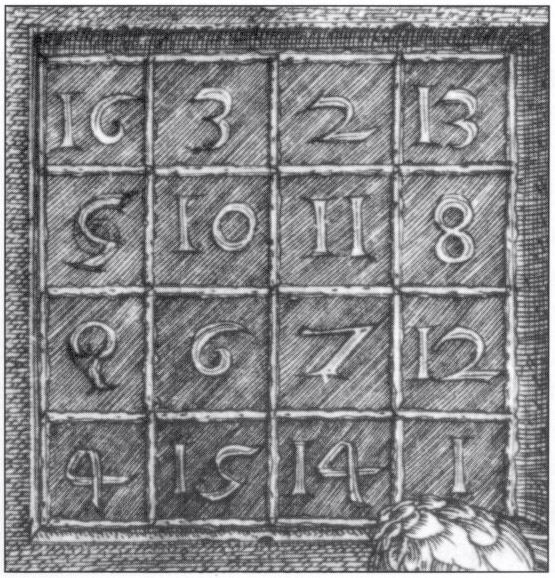
A key idea is that the magic square serves as a tool to counterbalance astrological influences—notably, the influence of Saturn, the ruler of melancholy, which governs limitation, repetition, and labor. The 4×4 square in Dürer’s engraving might correspond to Jupiter (Mushṭarī), though manipulated to include the date of its creation (1514) , counteracting Saturn’s melancholic grip, while the 3×3 square aligns with the angel of death (Isra’il), reinforcing its association with melancholy. Furthermore, there is a symbolic blending of good and evil within angelic representations, particularly in the juxtaposition of Mīkā’īl, traditionally a warrior angel, with the image of the architect’s compass—a tool of creation rather than destruction.
The magic square is a spell—it organizes reality through numbers.
The architect’s blueprint is a spell—it dictates form and function.
The algorithm is a spell—it governs behavior and prediction.
As architects, as thinkers, we stand at a crossroads. Do we remain trapped in the spells of the past, or do we rewrite them?
Now it is time to change the magic square used by Dürrer as a Talisman to bring the humors back to order and equilibrium into its original because we already know that this magic square is manipulated to let the date of creation embedded (1514). Here is the original one according to Al-Buni’s tradition:
|
8 |
11 |
14 |
1 |
|
13 |
2 |
7 |
12 |
|
3 |
16 |
9 |
6 |
|
10 |
5 |
4 |
15 |
Now let us replace each number with its equivallent letter:
|
ح |
ک |
ن |
ا |
|
م |
ب |
ز |
ل |
|
ج |
ع |
ط |
و |
|
ی |
ه |
د |
س |
Now, if we replace each letter with its corresponding humor we see that how and why the magic square of Jupiter is a remedy for bringing the four humors in equilibrium:
|
Water |
Wind |
Soil |
Fire |
|
Fire |
Soil |
Wind |
Water |
|
Wind |
Water |
Fire |
Soil |
|
Soil |
Fire |
Water |
Wind |
In this system, each Arabic letter is assigned to one of the four humors (Fiery, Earthy, Airy, Watery) based on its position in the Abjad numerology system. These humors are derived from classical elements and are used in astrology and divination (طالع بینی).